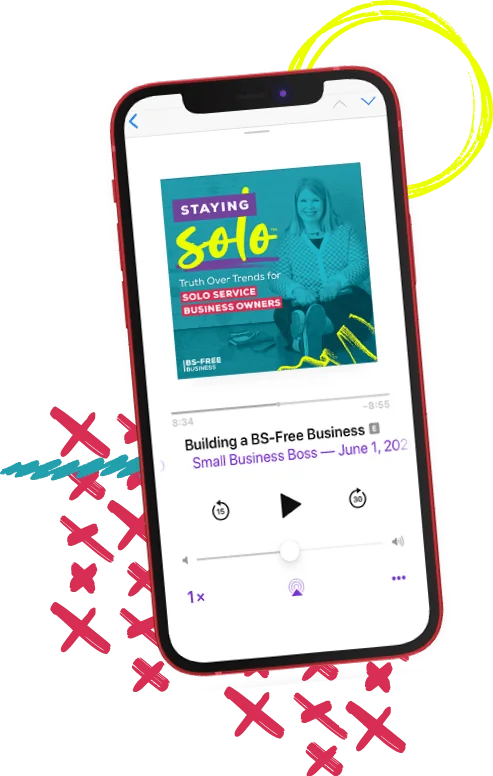
Search the site:
The Retainer Reality Check: The Hidden Risks That Are Costing You
You know that feeling when a client’s on a retainer and they message you with a “quick question”… And then that quick question turns into an hour-long strategy call…
This turns into a deliverable that wasn’t scoped. And before you know it, you’ve spent half your week on a $3K retainer that should’ve been $ 6 K.
Yeah. I’ve been there.
Retainers are excellent when they’re well-structured. But if you’re not careful, they’ll drain your team, energy, and bottom line.
Retainers Are Easy, Predictable Money
Here’s the fantasy we’ve sold: Land a few solid retainers, and it’ll be smooth sailing.
No more rollercoaster months. Just reliable income, happy clients, and a chill calendar.
But here’s the truth no one talks about: Retainers are only predictable when you’re disciplined about boundaries, scope, and delivery.
Otherwise, what you’ve actually built is a high-touch, low-profit Frankenstein monster that feels like a full-time job, with none of the benefits.
Here’s where my confession comes in: I used to believe retainers were the answer to all my agency revenue prayers—until I realized I was working more, earning less, and saying yes way too much without even noticing.
The Hidden Risks of Retainers
Let’s talk about The Hidden Risks of Retainers—the sneaky, slow-moving landmines that don’t just nibble at your profit… they devour your time, your energy, and your margins while you’re busy trying to “keep the client happy.”
These risks don’t show up with flashing lights. They creep in quietly, disguised as “just one more revision,” “a quick Slack message,” or “a small update.”
And before you know it? That retainer you were counting on for stable, predictable income starts feeling like a never-ending to-do list with a fixed paycheck.
No wiggle room. No upside. And there is zero acknowledgment of the actual effort involved.
So if you’ve ever looked at a retainer and wondered WTF is going on, you need to look for these risks.
Risk #1. Overservicing
Let’s start here because it’s the most common issue I see, especially for micro agencies with a client-first ethos.
You want to do a good job. You want to be generous. But generosity doesn’t pay your team, and it sure as hell doesn’t build a sustainable business for you.
For example, let’s say you include a weekly call. Then the client adds in “reviewing analytics,” “rewriting copy,” and “jumping on Slack for feedback.”
Suddenly, your $2,000 retainer clocks in at 15-20 hours/month. You’re making $100–130/hour before expenses. That’s not sustainable.
The real problem is that your client thinks it’s okay because you never told them otherwise.
Risk #2. Scope Creep That Feels Innocent
Scope creep doesn’t always come in screaming like a 20-item to-do list.
It often tiptoes in as:
- “Can you just take a quick look at this?”
- “Would you mind jumping on a call with our designer?”
- “This new campaign is related to what we’re already doing…”
Multiply that by a few clients and multiple weeks; your team is booked out with unpaid labor.
A great example is how a past client contracted me for content-related work but discovered I had PR experience. Then came all the questions about their strategy, reviewing materials, and so many extra tasks that they thought should fall under the “content strategy” part of the retainer.
You need an ironclad scope of work, including clear parameters on what services you don’t offer. Then, you need to reinforce it constantly.
Risk #3. Time Tracking Blackouts
Here’s what happens: You land the retainer, it’s a flat rate, and you breathe a sigh of relief. So you stop tracking time.
It’s a bad idea because now you have no clue what it’s costing you to deliver that service. And once you factor in meetings, emails, admin, internal review, and project management?
That $5K/month retainer might be operating at a 20% margin—or worse, zero.
It’s far too easy for micro agencies to end up busy and broke. You need to know your internal delivery cost. Otherwise, your margins will quickly disappear.
Risk #4: Unbilled Hours
There’s so much time that simply doesn’t get billed. I’m talking about internal team huddles, endless Slack threads, Loom videos to give your team feedback and post-mortems on projects.
Too often, your team will see this as “admin” work and assume these hours aren’t billable. They don’t get captured, and you’re wondering why your team seems so busy, but the billable hours aren’t there.
If the hours aren’t tracked, you’ll never be able to bill for them or get a handle on your internal delivery costs. Even if it’s “admin” work, every hour should be accounted for.
Your Retainer Reset
Now that we’ve aired out all the dirty laundry around retainers, you may wonder if you should just burn them to the ground.
Retainers aren’t the problem. The lack of structure around them is.
When they’re set up well, retainers can be a powerful part of your micro agency’s revenue. But they’re not a set-it-and-forget-it situation. You can’t just slap a flat fee on a bundle of services and hope it works out.
What retainers need is a reset. They need boundaries. They need systems.
Most importantly, they need you to manage them with the same strategic thinking you use when approaching big client projects.
Here’s how to make retainers work for your micro agency:
Reset #1: Scope It Like a Lawyer Would
If you’ve ever worked with a lawyer or have friends who are lawyers, you know that they don’t mess around. They do structure, and they track time in six-minute increments.
Do you need to be that rigid? No, but we can all learn something from how lawyers do things as they focus on clear deliverables, defined timelines, revision limits, and meeting policies and bill you for ALL of it.
Revisit how you onboard your clients and ensure you put your “rules of engagement” in writing, and then ensure you and your team are tracking time in a detailed and helpful way.
Reset #2: Track Time Even If You Don’t Bill It
Time tracking is a drag, but you need the data to analyze your pricing, services and team performance.
As the saying goes, “You can’t manage what you can’t measure.” In any professional services organization, time is something you can measure, whether you bill by the hour or not.
With timely and accurate time tracking, you can use the data to:
- Adjust retainers
- Spot overages
- Justify price increases
- Protect your team
- Reset client expectations
- Recoup cost overruns
Reset #3: Quarterly Retainer Review
Suppose you’re not reviewing your retainers at least once a quarter. In that case, you may miss opportunities to tighten up deliverables, increase pricing, or course-correct before things spiral into overservicing, burnout, or bleeding profit.
That “good client” might be slowly, silently, and consistently bleeding your profit.
Here’s your quick-and-dirty Retainer Profit Check:
Are we still making money? Not in theory. Not “feels like it.” Actual dollars. Are the margins still healthy?
Has the scope crept? Are you doing more than what’s in the agreement, either because the client asked or you didn’t push back?
Are we still the right fit? Has the client evolved in a direction that no longer aligns with your expertise or your values?
Are the deliverables aligned with our zone of genius? Just because you can do something doesn’t mean you should. Are you spending time on what you’re best at?
Don’t overcomplicate this. Pull the hours. Look at the revenue. If the math doesn’t make sense, it’s time for a reset.
Reset #4: Build in Boundaries & Enforce Them
A retainer without boundaries is a free-for-all. And guess what?
If you don’t set the rules, your clients will—and they won’t hold back.
Here’s how to draw the line before things get messy:
Limit meeting time per month
You’re not on call. Set a cap on meetings (and make it clear how to book them). Guard your calendar like your profit depends on it—because it does.
Define what Slack (or email) support includes
Real-time messaging doesn’t mean real-time responses. Clarify when and how clients can reach out—and what kind of requests won’t be handled via chat.
Create clear upgrade paths for extra work
More deliverables? New strategy ask? Last-minute fire drill? Cool. Here’s the add-on rate. Scope creep becomes a sales opportunity when you’re ready for it.
Say “that’s outside of scope” without flinching
You’re not being difficult. You’re being professional. Boundaries aren’t bad service—they’re what make excellent service possible.
Teach your clients how to work with you
You set the tone. From onboarding to weekly check-ins, reinforce your boundaries like it’s second nature. Because if you don’t? Clients will assume everything’s fair game—and that’s when the chaos starts.
Reset #5: Know When to Walk Away
If a retainer is no longer aligned—financially or energetically—let it go. Yes, even the “good” ones.
Especially the good ones that are keeping you from growing. Exit gracefully, but exit.
Retainers Aren’t the Problem: It’s How You Manage Them
Retainers can be incredible. They can give you stability, structure, and sanity—when done correctly.
But let’s not pretend they’re magic for your micro agency. Because when the boundaries are blurry, the scope is loose, and no one’s watching your hours
That “steady” income starts to feel like a slow bleed.
Retainers are a tool. Not a solution. And like any tool, they’re only as useful as the systems you put around them.
If your retainers start to feel more like a burden and the math isn’t mathing, it’s time to look closer.
Pick one retainer and run a quick audit:
- What’s in scope—and what are you actually delivering?
- How many hours are you or your team spending?
- Is it still profitable?
- Is the work aligned with what you want to be doing?
- Do you even want to keep this client anymore?
And if you’re thinking, “Uh, this might be a mess…” remember, there’s power in knowing what’s really going on so you can face reality and reset as needed.
If the first half of the year felt like a blur, you’re not alone—and you don’t have to keep winging it. Join me for Mid-Year Momentum, a free planning workshop built specifically for micro agency owners who need a practical, no-fluff reset.
During this free session on June 16th, we’ll audit what’s working (and what’s not), cut through the chaos, and create a simple, strategic plan to carry you through the rest of the year.
No vision boards. No busywork. Just real support from someone who’s been deep in the agency trenches. Save your spot now.


I’m Maggie Patterson (she/her), and services businesses are my business.
I have 20+ years of experience with client services, am a consultant for agency owners, creatives, and consultants, and vocal advocate for humane business practices rooted in empathy, respect, and trust.
Read or Listen to the Latest
For Solo Business Owners

Growing a solo service business is tough.
It’s even harder when you’re bombarded with BS advice that steers you away from your values and why you started your business in the first place.
This is the podcast for solo creatives and consultants who want to remain as a team of one and have zero interest in the hustle and grind of typical business teachings.
Subscribe now and never miss an episode.
For Micro Agency Owners
Most podcasts for agency owners obsess over revenue growth as the ultimate success metric.

But here’s the truth: not everyone wants to make millions. Your goal might be to build a sustainable business that lets you have a life and doesn’t run you into the ground.
Join me as I spill my shameless confessions and share everything I’ve learned about building a micro agency that skips the BS of tired and typical agency teachings.
Follow Now on All Major Podcast Platforms







